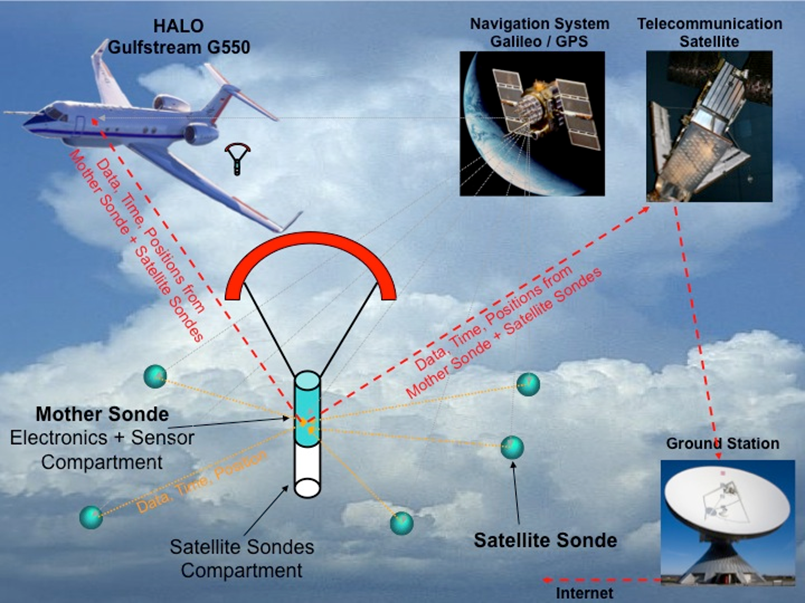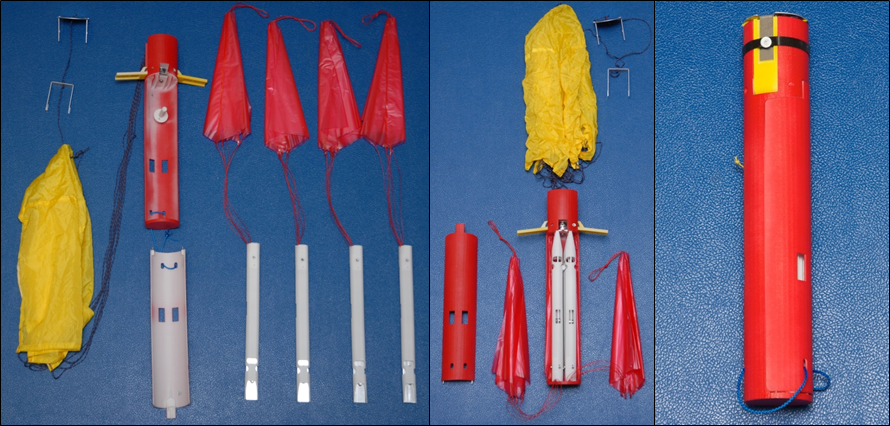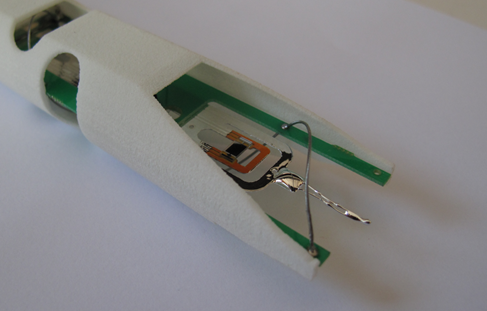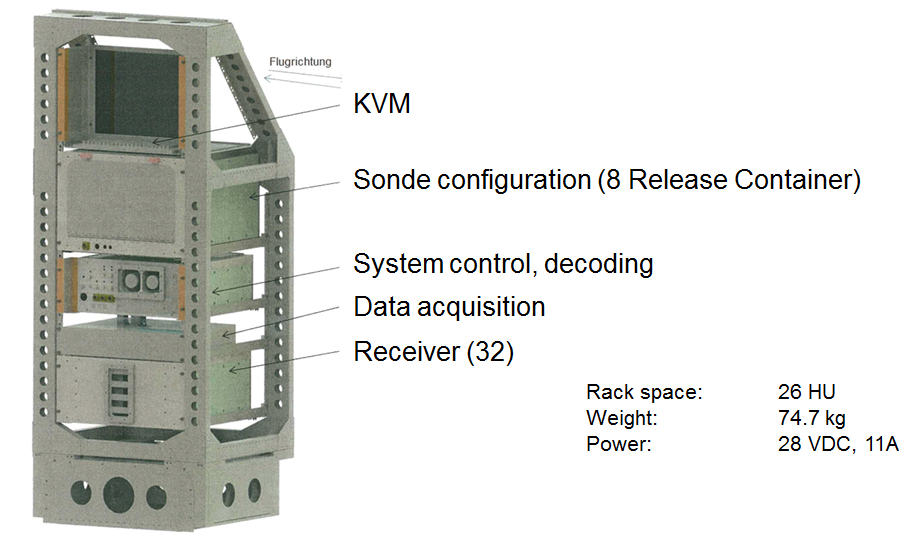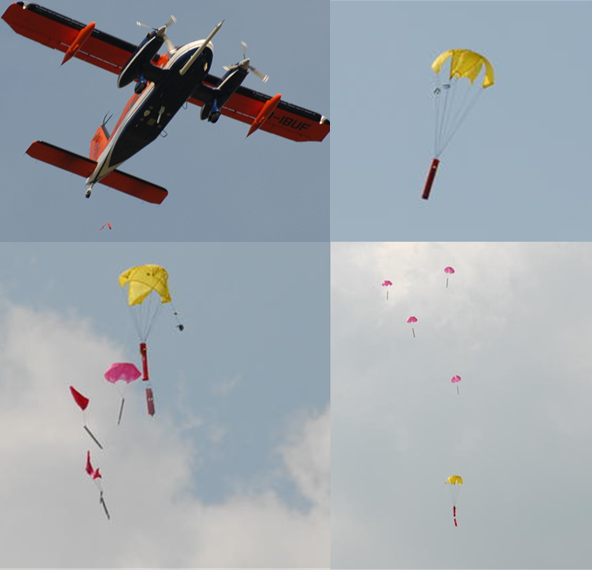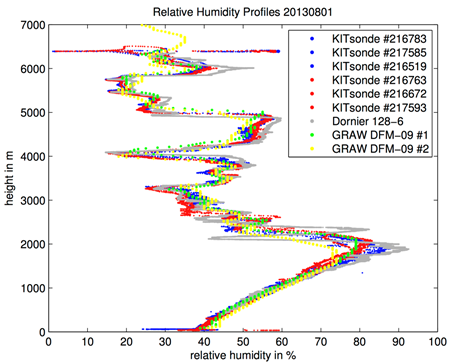KITsonde
The IMKTRO developed a new multi-sensor dropsonde system "KITsonde" for high and fast-flying research aircraft such as HALO. The modular design of KITsonde combines the strengths of existing dropsonde systems, such as the widespread AVAPS (Airborne Vertical Atmospheric Profiling System) and the Karlsruhe dropsonde. On the one hand the specificity of the new system is the possibility of being able to use up to 30 probes simultaneously to win spatially and temporally espacially high resolved measurements in the region of inhomogeneous zones of the atmosphere, such as convective cells or cyclones. On the other hand, the separation of probe and discharge containers allows the drop of up to 4 probes at the same time and the integration of new sensor technologies because in the first phase of shedding, the probes are decelerated safely protected with the waste bin. In the basic version KITsonde supplies profile measurements of pressure, humidity, temperature and wind with a necessary resolution that is adjusted for gaining a better understanding of the processes involved in the development of the above named weather phenomena. This data can be made available worldwide immediately if necessary through a direct satellite link to the probe. KITsonde ultimately lead to an improved predictability of occurrence and development of extreme weather situations. After an initial test phase in the spring of 2012 took place in August 2013 further test flights with the Dornier Do-128 IBUF. In May 2014, will be the first bombing of the fast and high flying aircraft HALO. In the development of this novel measurement system the IMKTRO works along with two industrial partners. GRAW Radio Sondes GmbH & Co. KG, Nürnberg develop and produce the meteorological measuring probe, which is comparable to the latest radiosonde generation DFM-09. The enviscope GmbH, Frankfurt / M. is responsible for discharge containers, aircraft fittings, control software, and certification of the system.
KITsonde design goals
- High-resolution measurements of up to 30 probes
- Shedding of up to 4 probes simultaneously
- Direct radio connection to the plane (400 MHz)
- Satellite telemetry as optional data transmission (Iridium)
- Compatible with popular shedding - systems
- Inexpensive modular design
- Easy integration of new sensor developments
- Any combination of probes and sensors possible
KITsonde development
KITsonde probe system consists of 3 main components:
- Multipurpose-discharge containers
- Meteorological probe
- Receiver and data processing unit in the plane
The compatibility of the newly developed discharge container with shedding facilities of AVAPS that are widespread on research aircraft KITsonde can be used easily on a variety of research aircraft . The new discharge containers allows the dropping of several, even different sensors at the same time, while the sensitive measurement technology is protected against severe mechanical stress during shedding (Fig. 4). The specific production of the container with sintered polyamide also allows a rapid adaptation, thus new sensors and interfaces can be integrated with minimal effort in the system. Development of new sensors can be, for example, Sensors for liquid water particles (aerosols, drops, volcanic ash) radioactivity, etc. As part of the test flights in August 2013 particle sensors for aerosol and cloud droplets at the University of Hertfordshire have been successfully dropped and tested (Ulanowski et al., DUST 2014).
Meteorological probe
The standard meteorological probe is closely related to the GRAW DFM-09 radiosonde which has performed very well at the "8th WMO High Quality Radiosonde Intercomparison, Yangjiang, China" . Special features of the dropsonde in comparison to radiosonde are:
- Stabilized 400 MHz transmit frequency
- 400 MHz transmit power switchable via jumper (reduced power in the aircraft cabin)
- special closing mechanism
- Transmission of time and probe number (probe ID)
- Connection option for an additional sensor
- Data output for connection to a satellite modem
- Software for initialization, data decoding and calibration
Specificaions of the meteorological probe
| Temperature sensor: | Thermistor |
| Temperature resolution: | 0.1 K |
| Temperature accuracy: | < 0.2 K |
| Humidity sensor: | capacitive sensor (thin film) |
| Humidity resolution: | 0.1 % relative humidity |
| Humidity accuracy: | < 5 % relative humidity |
| Accuracy of the geopotential height: | < 10 m |
| Accuracy of the wind speed: | < 0.2 m s-1 |
| Position accuracy (horizontal): | < 5 m |
| Height, Weight: | 309 x 24 mm , 75 g |
Aircraft receiver
The aircraft receiver is based on a traditional superheterodyne design. This enables a compact and low power consumption. The receiving unit of KITsonde contains 32 high-sensitivity receiver, one of them constantly scans the frequency band for free frequencies, and a second is used for the probe control before dropping . The remaining 30 receivers are available for the simultaneous reception of the data streams of dropped probes. These are decoded in the data acquisition system in real time, stored, and displayed graphically. For use of KITsonde only one person, which has access to the configuration and control software with a graphical interface directly to the device unit in the parrel of the airplane or via the onboard network from any PC on the airplane, is required on board the aircraft. Simultaneous operation of KITsonde and AVAPS is always possible, because KITsonde provides the connections for a sharing of the receiving antennas of the aircraft.
Test flights and data quality
With a simplified KITsonde system test flights with drops were already done. The drops were used both for the evaluation of the reliability of the discharge container and for receiving the first profile measurements. The gained data were analyzed and compared with various other radiosondes (DFM-06, DFM-09, Vaisala RS92, Karlsruhe dropsonde) and in situ aircraft measurements of the Dornier Do 128 D-IBUF of the TU Braunschweig. Test measurements with the new probe in laboratory and profile measurements provide good quality data (Fig. 7).
Future prospects
The test using of the KITsonde on the high and fast flying aircraft HALO is scheduled for May 2014. After that, its use in the measurement campaigns POLSTRACC and WISE done.
Further information
Contact
Dr. Andreas Wieser
Email: andreas wieser∂kit edu
Phone: 0721 - 608-22841

